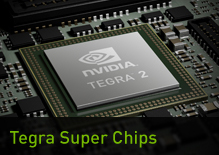Friday, January 14, 2011
Nvidia gains ground in battle with Intel
Nvidia's stock has skyrocketed recently as it has become apparent that the company could be a key player in the lucrative mobile processor market and has plans to make chips for personal computers and servers, challenging the monopoly of its large Silicon Valley rival, Intel.
Eager investors have pushed Nvidia's stock up over 50 percent in the first half of this month alone as they anticipate the company will emerge from its niche graphics card market to become a major threat to the larger chip makers, including Intel and Qualcomm.
I have followed Nvidia closely for many years as I anticipated they would one day grow out of their niche market and challenge their bigger rivals. My very first full-length Silicon Valley Blog post was about the early battles between Nvidia, which was pioneering parallel computing, and Intel, whose serial computing technology was becoming dated. My second feature blog post was also about Nvidia and a patent dispute over chipsets that combined Nvidia's graphics cards with Intel's x86 CPU.
In October, 2008, a few months before my first Silicon Valley Blog post, I started my Silicon Valley 2.0 stock portfolio. The fund has gotten a big boost from its Nvidia holdings and is now outperforming the S&P by some 32 percent annually.
No less than three financial firms raised their stock price targets for Nvidia this week, confident that the company would benefit from its $1.5 billion patent settlement with Intel and the sale of its new Tegra 2 chip to several large makers of Android smartphones and tablets.
Pointing to the growing popularity of Android mobile devices, Needham and Co. told clients that "investors looking to capitalize on the potential adoption of non-Apple tablets should focus on Nvidia as one of the key suppliers into this market."
Nvidia's new Tegra 2 chip was the first dual core processor developed for mobile devices. Apple's popular iPhone 4 has a less powerful chip with a single core. The leading makers of Android smartphones and tablets are adopting dual core chips in an effort to compete with Apple's iPad and iPhone, both of which dominate the mobile market.
Last year, smartphones with fast processors got most of the attention, reports Silicon.com. According to Ovum analyst Nick Dillion, that's no longer the case. "In the same way that 1GHz was the standard for top of the range smartphones in 2010, every top-end service in 2011 is likely to have a dual-core processor," Dillion predicted. "We may even see the first quad-core chipsets emerging in handsets by the end of the year."
There are rumors that the successor to the iPhone 4 will also have two cores. Even with only one core, the iPhone 4 is in no immediate danger.
Ian Fogg, chief analyst at Forrester Research, points out that "where the iPhone is competitive is because the software and the apps, particularly the games, are taking full advantage of all the hardware abilities of the iPhone 4 - the graphics and the processor and the memory and everything else. It will take some time for the first dual-core phones - most likely on Android - to gain that advantage."
Fogg adds, "Consumers care about the overall experience. They care about the software, the overall package. What can it do for me, how good are the games, how good is the video playback, how good is the camera? And really, dual-core is an enabler of all these things - but it isn't sufficient in its own right to create a compelling environment."
The first mobile phones and tablets with dual cores were unveiled at the recent Consumer Electronics Show in Las Vegas. Motorola's Xoom tablet was considered by many to be the hit of the show. The LG Optimus 2X, the first dual core smartphone, was a central part of Nvidia's CES presentation. The Xoom, one of three new Motorola devices, the Optimus 2X, along with mobile devices from Acer and HTC, all debuted at the show with Nvidia's dual core Tegra 2 processor.
The traditional mobile chip with only one core has to operate at higher speeds, and therefore, is not as power-efficient as processors with two cores running at half speed, reports Technology Review. "Running a processor at a higher frequency means increased voltage, greater resistance, and so more heat produced," says Matt Wuebbling, a senior product manager for Nvidia's Tegra 2, which operates in tandem with the company's graphics processing units (GPUs).
"With this chip, games are completely different to what we think of as mobile games with cartoon graphics," explains Wuebbling. Tablets using the Tegra 2 chip can now play games with 3D graphics. "That's possible because we have dual cores and a GPU," he said.
Nvidia points out that browsing the Web will be twice as fast with its Tegra 2 processor. Linley Gewnnap, the noted chief microprocessor analyst at the Linley Group, concurs. "Dual-core processors will better be able to keep up with the speed at which wireless networks can download pages," he said.
Nvidia also got a major boost at CES when Microsoft announced that future versions of its Windows operating system would support ARM chips, the standard core of mobile phones worldwide, for the first time.
Bill Dally, Nvidia's chief scientist, announced Project Denver, a major initiative to use the ARM architecture to make processors for personal computers, servers and supercomputers, at CES. The computer market has long been dominated by Intel's x86 architecture, which it would not license to Nvidia.
Jen-Hsun Huang, Nvidia's CEO, declared that Microsoft's support of ARM designs would make this year's CES a historic event. "This year the personal computing industry is redefined," he said.
Subscribe to:
Post Comments (Atom)

Wow! Awesome i hope nivida gain its popularity in market.
ReplyDeleteThanks for sharing your thoughts on this matter. You make some interesting points.
ReplyDelete